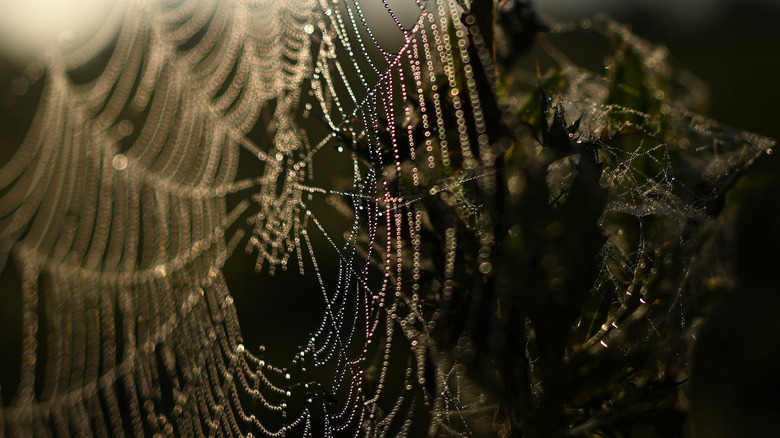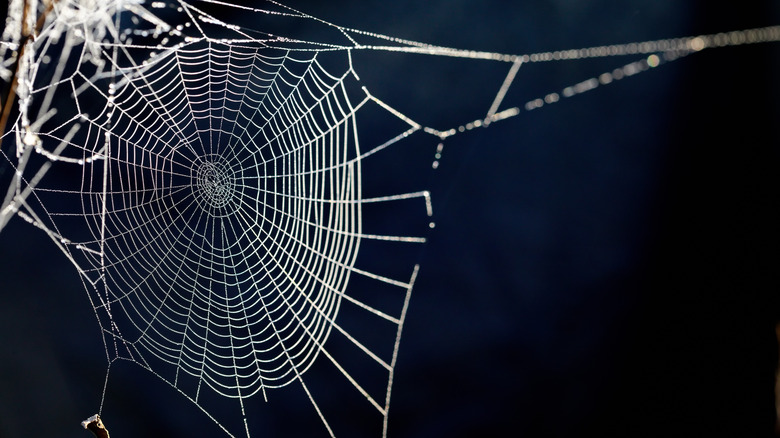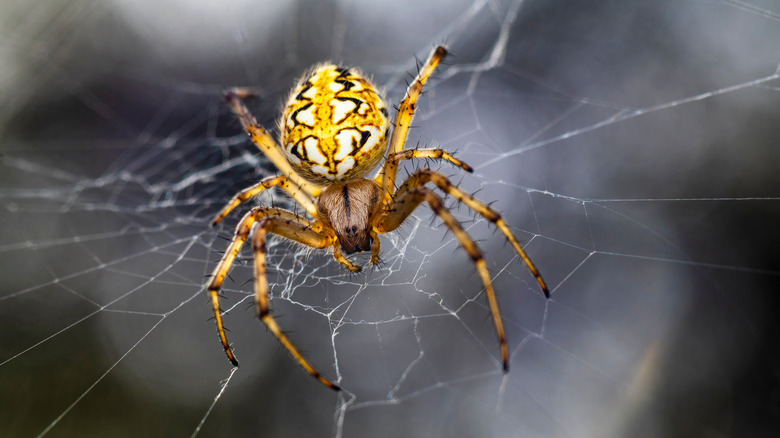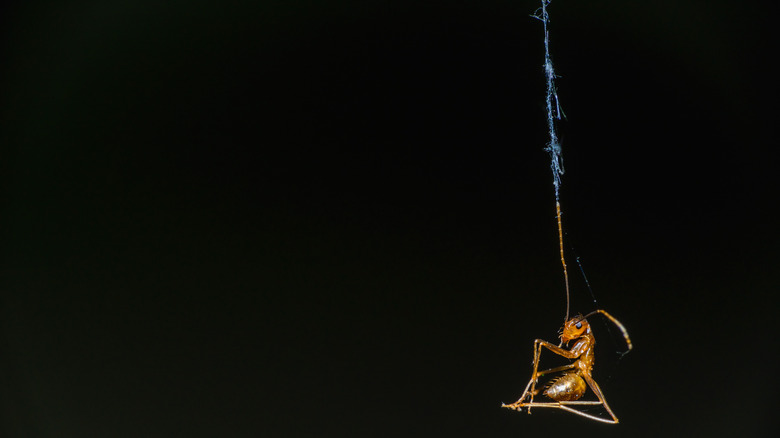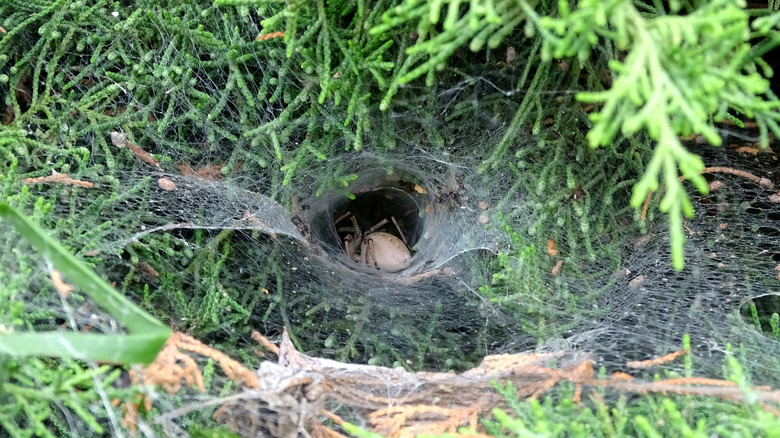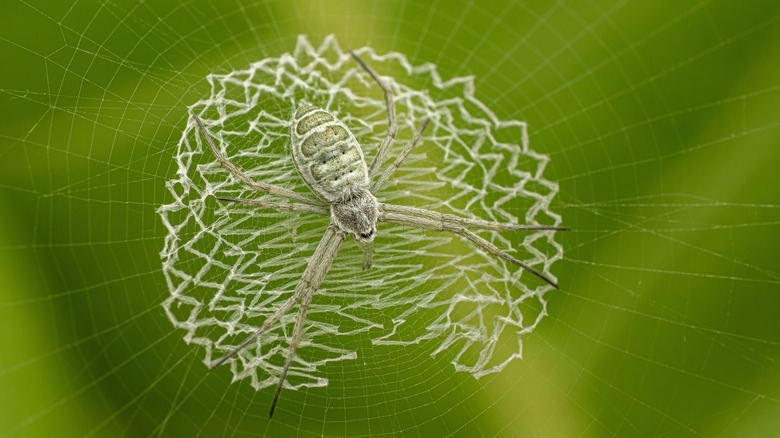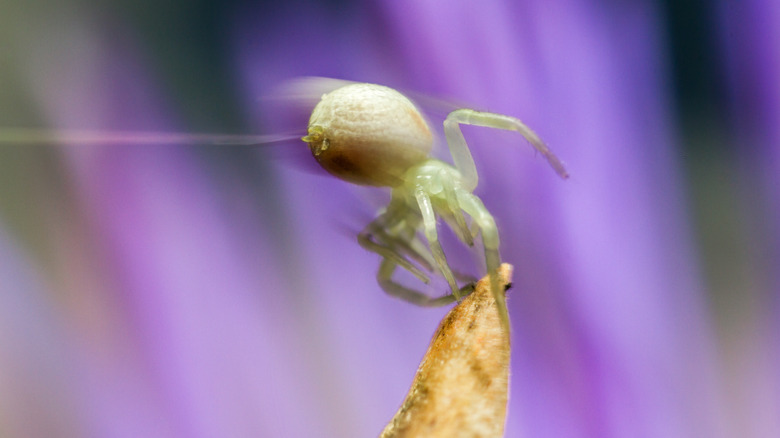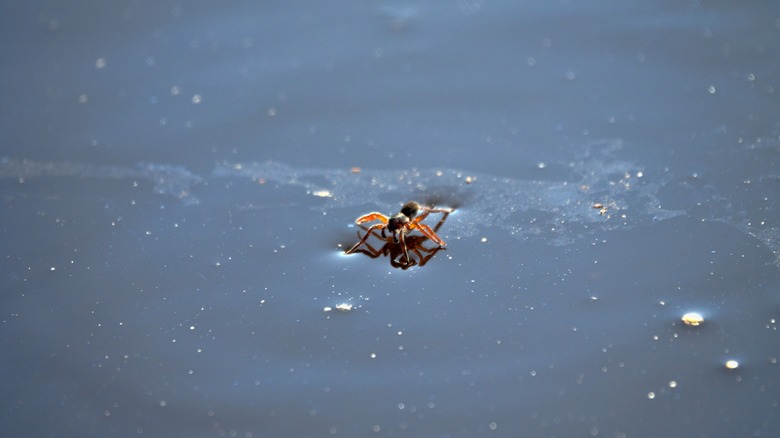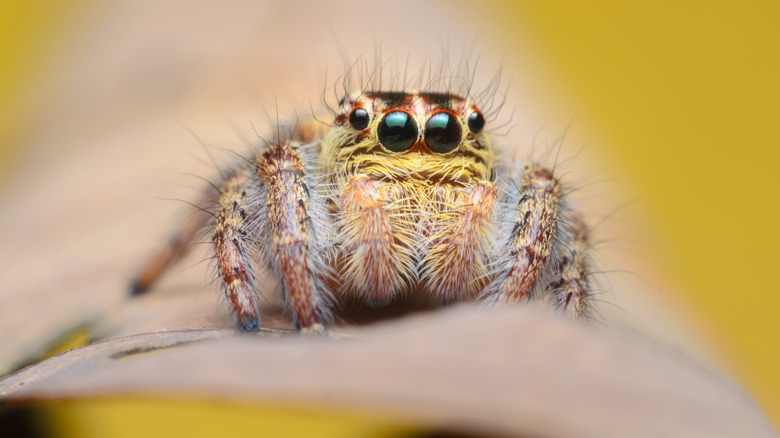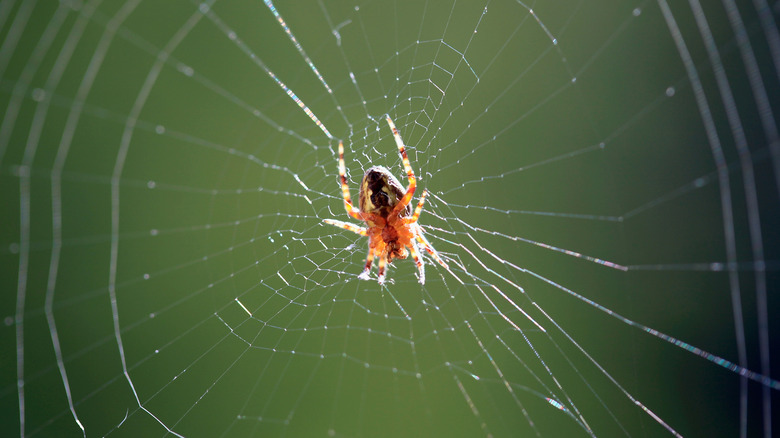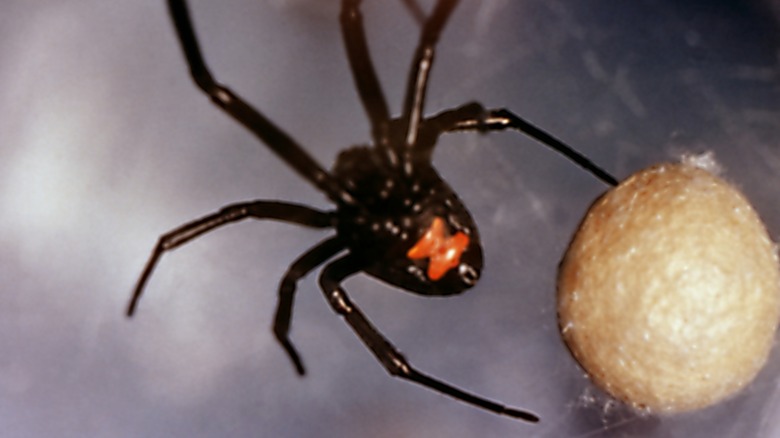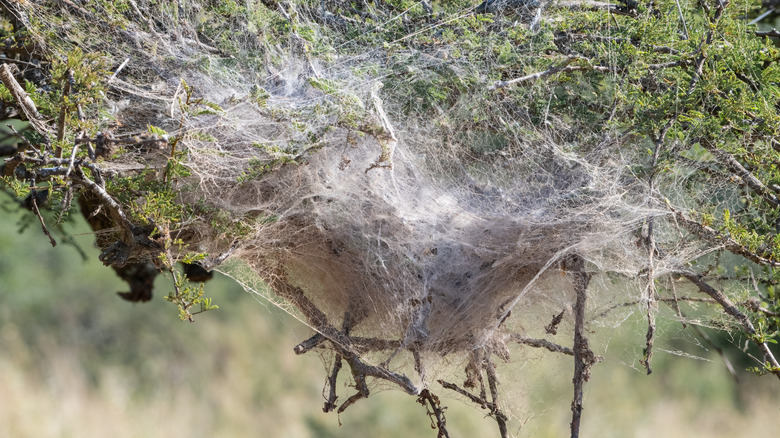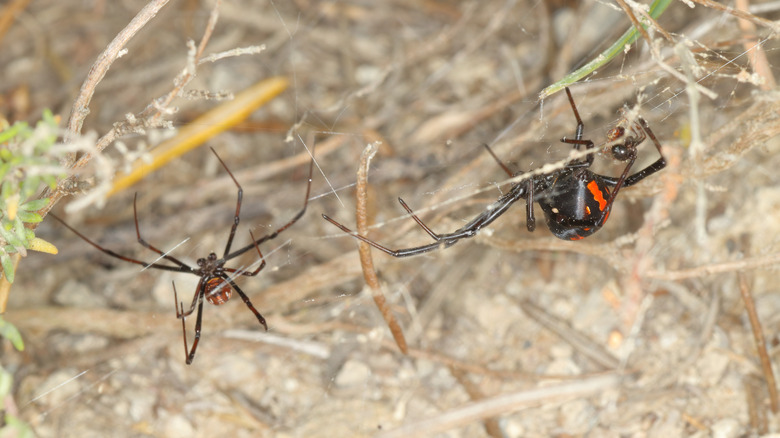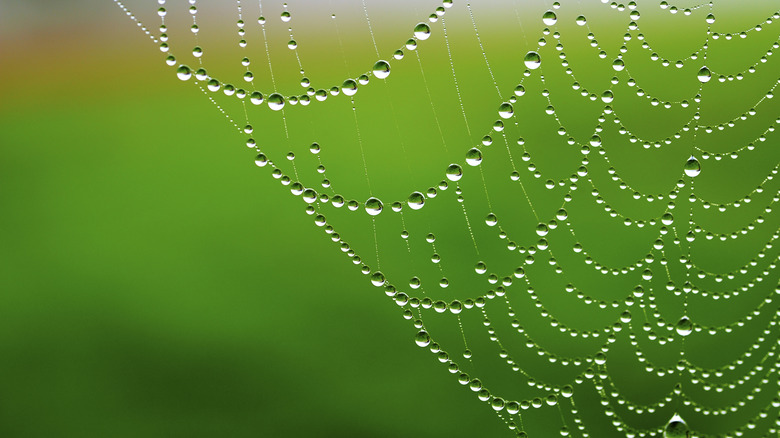Fascinating Facts About Spider Webs
Spiders are incredible creatures. These venomous arachnids are found all over the world and range in size from the .011-inch Samoan moss spider to the massive one-foot-wide Goliath birdeater, which eats not only birds but frogs, rodents, and a staple of insects. Possibly the most commonly recognizable aspect of spiders is their silk webs.
While most people may hold a generic image of spider webs in their minds — circular, delicate gossamer-like structures woven into intricate geometric patterns, just waiting to get tangled in the hair of the unwary dog walker — they can take many forms. Their purpose can also extend to far more than just catching flying insects, and the very material they are woven from — silk — has a multitude of essential roles for spider survival, too.
Spider webs and the silk they are made from are biological wonders, ones that scientists continue to study closely. Arachnophobes beware, but if you're not too creeped out yet, here are some fascinating facts about spider webs.
Nanofibrils create incredible strength
Spider webs are ludicrously strong for their size. The University of Bristol reports that if you made a cable of spider silk and manufactured an identical steel cable, the spider silk cable would be five times stronger than the steel one. Spider webs are close in strength to Kevlar, and scientists have suggested that if you made a spider silk rope the width of a pen or pencil, it could lasso and stop a flying jumbo jet airliner.
Based on these physical properties, it is easy to see why scientists and engineers are gaga over the potential uses of spider silk. Scientists have recently analyzed silk from recluse spiders and discovered why it is so tough. The results, published by ACS Macro Letters, show that the silk is composed of thousands of microscopically slender, intertwined fibers. These protein-based strands, called nanofibrils, measure in the nanometers. Another study published in Acta Biomaterialia states that the way these nanofibrils are arranged endow spider silk with its natural elasticity. If scientists can figure out a way to replicate this incredible material, then it may only be a matter of time before suspension bridges are held up with fibers the width of a string of yarn.
There are many kinds of web silk
Spiders live a complex life of catching prey, building webs, dropping from heights to startle you, and reproducing. To perform these various arachnid activities, silk is necessary. Spiders produce their silk through their spinnerets, but amazingly, not all spider webs are created equal. Spinnerets can produce seven types of silk, which are each used for different purposes (per The University of Bristol).
A specific type of silk is used for wrapping prey, another is used to form egg sacs, and silk of a yet different composition makes long, non-sticky draglines — these are the kinds mainly used to build webs. Some spiders can even produce silk that acts like cement. To generate each type of silken thread, spiders are able to control the combinations of proteins used, secreted from various glands.
No species of spider yet found can make each type of silk, of which seven are known, although all spiders produce the tough draglines. Which kind of silk a spider can spin depends on the species and also sex. For example, only female spiders produce the silk that is used to make cocoons.
Web lassos
One popular notion about spider webs is that they are purely passive. That is, a spider forms the web and sits around waiting for lunch to fly into it. However, the truth is that some spiders actively use their silk to catch their meals, much like the way Spider-Man shoots webs to tie up supervillains.
According to ScienceNews, most spiders avoid eating ants, which can inflict a powerful bite and may also be venomous. Those spiders that do attack ants usually ambush them from the rear or let them get entrapped in a web — all child's-play compared to the remarkable Australian ant-slayer spider's creative use of its silken powers.
A study published by PNAS reported that the Australian ant-slayer has figured out an acrobatic way to deal with and dine upon ants. From a head-down position on a tree trunk, the spider waits for an unlucky ant to amble by. Then, when one comes into range, it launches itself into flight over the ant and shoots a web onto it. The spider then lands and bounds around the captured ant, looping it in a sticky lasso to immobilize it, before the spider sinks its fangs into its dinner. The whole hunt is over in a fraction of a second, and apparently, the technique is so successful that this species almost exclusively eats ants.
Webs started as tripwires.
The kind of spider web most people are familiar with can be found in any garden, and their function is also well-known. Strung taut between supports, such as tree branches, they are held aloft in wait for flying insects. However, spiders have been using silk for some 300 million years, and the webs we recognize today were not the first use of silk.
Spider experts, like William Eberhard in "Spider Webs: Behavior, Function, and Evolution," explain that spiders originally spun silk to create their egg sacs and to line burrows. Primordial spiders did not hang out in webs, but waited in their burrows for a victim to wander by. In time, the silk that extended from the den became a kind of sensor that alerted the spider to the presence of prey. It is believed that larger and more elaborate spider webs were an extension of this, since they provided the spider with a greater range to capture prey and sense nearby enemies.
Some spiders still use this tripwire system, such as the highly poisonous funnel-web spiders found in Australia. These spiders live in dens, under rocks, or in crevices. To catch their prey, they lay out silk in an irregular pattern of trip lines. When a meal stumbles into one, the spider charges out, injects it with venom, and drags it back to its den.
Decorations can attract more prey ... and predators
Spider webs are objectively pretty, but some spiders go the extra mile and decorate them, and for this, they turn to another variant of their preferred construction material. Orb-weaving spiders spin a kind of silk called stabilimentum, which can be used to build some rather well-appointed structures.
The exact function of decorative stabilimenta is debated, with proposals ranging from structural to physiological benefits. Some intriguing research, published by the Proceedings of the Royal Society, suggests that the highly conspicuous stabilimentum attracts prey. These structures reflect ultraviolet light exceptionally well, and it has been experimentally demonstrated that insects are drawn to them at a greater rate than undecorated webs.
This insect signage comes with a price, though. Another study (via the Proceedings of the Royal Society), argues that the reflective patterns signal to spider predators that soup is on. In fact, some predators may even learn the specific color of the structures to purposefully seek them out.
Flying by web balloons
One of the most remarkable abilities of spiders is that they can use their silk to fly. Using long silken strands, spiders are lofted into the atmosphere in a technique called ballooning. In fact, some spiders can reach heights of 2.5 miles, right in the jet stream. Ballooning allows some species of spiders to travel incredible distances. For example, Science News reports that the ancestors of a species of trapdoor spiders probably traveled from Africa to an island off Australia by wafting on spider silk. Spiders use ballooning to expand their range and settle into new territories.
While ballooning is fascinating in itself, a recent study published in Current Biology shows that some species of spiders can use this technique with Earth's electrical field. In experiments, researchers found that some species of spiders ballooned when placed in a chamber with no airflow but containing an electrical charge, using the electric field as a means of takeoff. While these spiders may seem to have preternatural abilities, it is all biology. Spiders detect the electrical field by hairs called trichobothria, much like how human hairs spike up from static electricity, but far more sensitive.
Underwater homes
Ranging from northern Europe to Siberia, the water spider, or diving bell spider, is the only spider species that lives entirely in water (per Animal Diversity Web). It owes this aquatic existence to its silk.
To establish itself, the spider casts webs between plants underwater. Then, it swims to the surface, exposing its abdomen to the air, where the spider's hair snags little bubbles of air. The spider swims back to its underwater web, where it plants the airdrops. This results in an underwater cave held in place by a webbed ceiling. Then, bit by bit, the spider expands the structure to make a more capacious den.
Diving bell spiders use these nests as their base camps and hunting blinds. Threads of silk from the nest protrude into the water, where if a prey item hits it, it signals the spider to pounce. The nest is also where the spiders can molt, mate, or just enjoy a leisurely meal. Most importantly, the den acts as a cache of breathable air. The spiders can detect if oxygen levels are getting too low. When that happens, the spider swims up to collect more air. During the winter, it swims deeper and builds stronger nests in objects such as snail shells.
Protection from extreme environments
Spiders can build homes that, while not palatial, protect them from the elements. For example, many spiders use their silk to create lining for shelters. For example, funnel web spiders in Australia typically inhabit cracks and crevices near building foundations and line them with webs.
In other places, the silk becomes even more critical for survival, and one of the most extreme examples is the Himalayan jumping spider. These little creatures are most likely contenders for winner of the terrestrial animal who lives at the highest elevation contest, with specimens found as high as 22,000 feet, on Mount Everest.
Such elevations produce extraordinarily harsh and cold conditions. To survive, these spiders use their webs to create makeshift shelters by spinning silken chambers or cells among the rock falls. Food is scarce, but this species manages to eke out a living feeding on insects that come up the mountain to forage on vegetation blown up by the mountain winds. The entire ecology, an Aeolian biome, is dependent solely on windborne particles of food — and at the top of the food web, thanks to its snug alpine web nests, is the jumping spider.
They are tuned like instruments
Spider webs seem to be delicate, gossamer structures. To maintain the structure of a web, spiders employ a form of maintenance more in line with that of a piano technician. Research in the journal Advanced Materials shows that as part of the maintenance process, spiders pluck at their webs in what can only be described as tuning, where the strands of a spider web are treated like the strings of an instrument. The strands are of different lengths and thicknesses and emit different resonances when plucked, so the spider, as the maker and master of these strings, can feel what is occurring in their home through acoustical vibration.
When a spider plucks its web, the sound is bounced back, which informs it of damage to the web, the presence of a snack, or maybe a potential mate. In fact, NPR, which commented upon the research, noted that the information given back to the spider is so detailed it allows them to know precisely where in the web the prey is, or where damage has occurred.
They can be tailor-made from liquid in an instant
When a spider gets busy making a web, it extrudes silk from spinnerets located on its rear. This fascinating process involves an impressive feat of biochemistry, where the stored spider silk undergoes an instant phase change.
The stuff that becomes spider silk (called "dope") is kept in liquid form before being used. Research published in Science Advances explains how dope passes through channels in the spider's body to the spinneret. In doing so, the protein-laden liquid, which is comprised of individual structures called spidroins, self-assembles. It folds and interlaces to instantly form spider silk.
More remarkably, the spider can choose what type of web to spin at will, ranging from ultra-strong draglines to an egg sac. The trigger for determining what kind of silk occurs when the dope is exposed to acid as it exits through the spinneret. Meanwhile, the substance is lengthened and linked up through countless ducts which continuously narrow. This process, built upon millions of years of evolution, is extraordinarily complex, and the method by which spiders spin their webs varies from species to species.
Web cities
Some species of spiders live highly social lives, and can gather together into enormous colonies. Using their webs, they create what can only be described as "spideropolises." Popular Science reports that the South American rainforest is home to some of the largest colonies of social spiders, such as the species Anelosimus eximius . A large colony of these spiders can be nearly 16.5 feet tall and over 13 feet wide. However, the authors of "Lessons From Amazonia" state that the typical size is about several cubic meters, which still translates to over a hundred cubic feet.
The colonies are composed of a sheet web, which is usually embedded high up around plants, trees, or other hangings. These types of massive and unorganized webs do not rely on stickiness to catch prey. Rather, the individual silk strands are so thin they can snag the hairs on individual insect bodies. Communal living in these massive webs has its advantages: The spiders share egg-tending duties, working together to repair webs, catch larger prey, and share food.
They are used in mating
There are many species of spiders that, when mating, the male is eaten by the female. Black widow spiders, for example, earned their name from this behavior. Although many male spiders seem to prefer to die while mating, some would reasonably prefer not to be cannibalized, so they employ their trusty spider web skills to survive their date.
For example, males of species such as Ancylometes bogotensis and Nephila pilipes are many times smaller than the much more aggressive females. The males use their silk to tie up the females during courtship to protect themselves. The silk can be used as a light covering of pheromone-soaked silk, or a more substantial bond for the legs. In all cases, this activity only seems to be intended to calm the female, which facilitates the mating process. In this way, the calming function of the silks seems to be more important than the actual physical restraint — after all, the female spiders can break out of the silken bonds quite easily when mating is finished.
Water collecters
One of a spider web's more unexpected features is its ability to retain water droplets. If you ever see dew hanging heavily off a spider's web in the morning, this is because they were designed to do so. Zheng Yongmei, in "Bio-Inspired Wettability Surfaces," explains that the structure of nanofibrils, which comprise spider silk, have spindle knots and joints that are very effective at collecting water.
Inspired, scientists and engineers have created artificial spider webs with an eye toward addressing water shortages. They found that by taking a synthetic fiber and placing spiral bumps in it, like those found in spider silk, water naturally collects through condensation. In fact, the amount of accumulated water is staggering since one of these bumps can hold up to 2,000 times its volume of water. And if this technology can be scaled up, it may alleviate unstable water supplies around the world.
